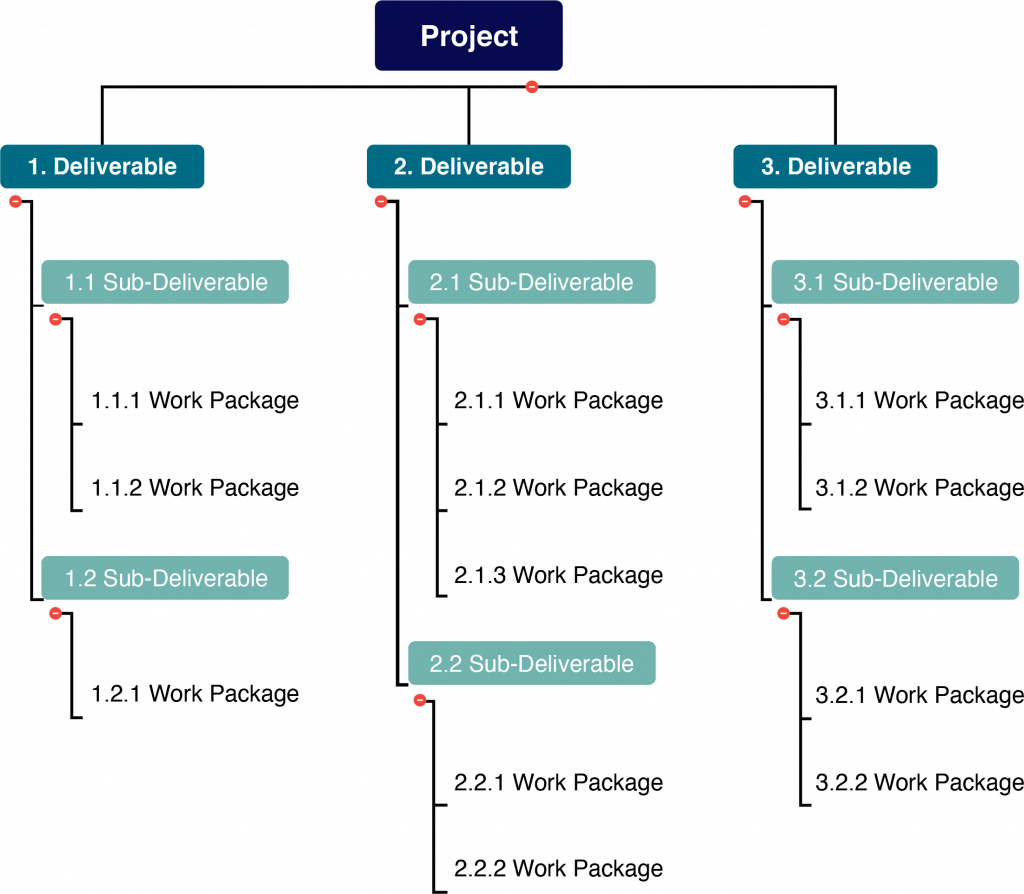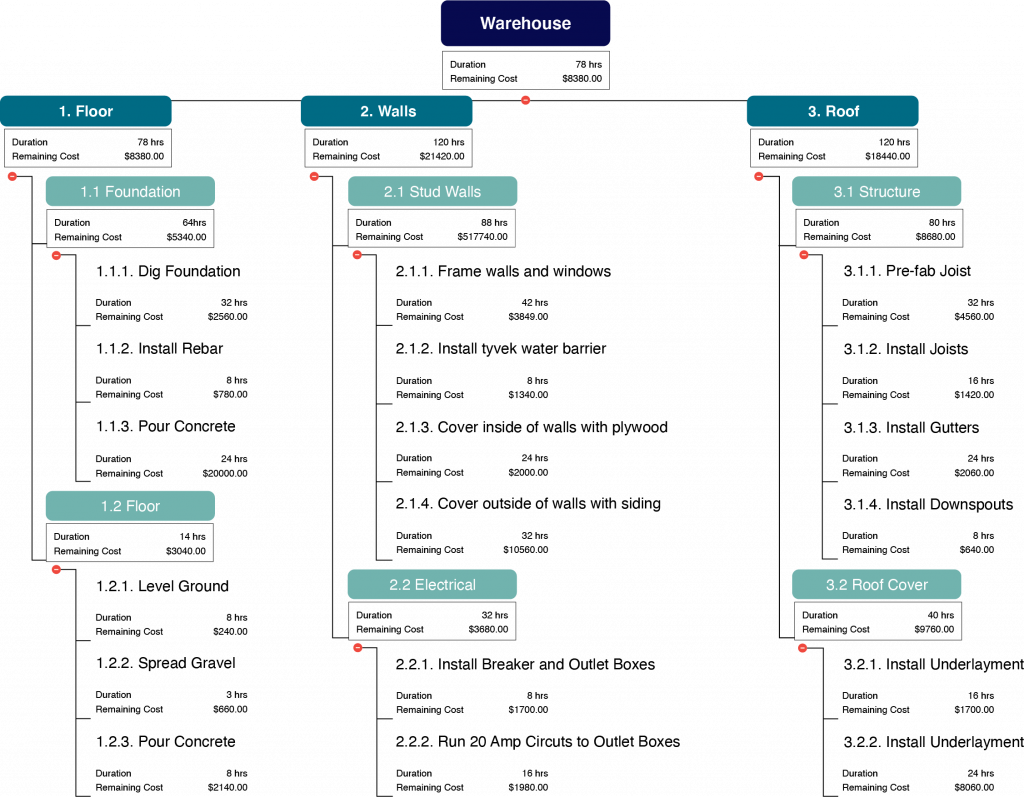5.4. Work Breakdown Structures
The WBS is a hierarchical outline of all the deliverables involved in completing a project. The WBS is part of a project scope statement. The creation of a WBS is one of the first steps in organizing and scheduling the work for a project.
The WBS is a breakdown of a project into sub-deliverables and eventually work-packages. Each level of the WBS, represents more detailed information about a project. Figure 5.1 shows how the project is broken down into major deliverables and then into sub-deliverables and work packages.

Deliverables vs. Work Packages
Deliverables and sub-deliverables are things such as physical objects, software code, or events. In a WBS, deliverables and sub-deliverables are represented by nouns (see Figure 5.2). Work packages are assignable units of work that will be performed to create the related deliverable. A work package can be assigned to one particular project team member, one outside contractor, or another team. The work packages may be further broken down into activities or tasks by the project team or the experts who will perform that work (see WBS dictionary later in this section).
Work packages are action-oriented and will be represented by phrases containing verbs (see Figure 5.2). The cost of a deliverable is the sum of all of its related sub-deliverables.
In Figure 5.2, the cost of the Walls deliverable is the sum of the Stud Walls and the Electrical sub-deliverables ($17,740 + $3,680 = $21,420). Likewise, the cost of a sub-deliverable is a summary of all of the work packages that must be completed to complete the sub-deliverable.
In Figure 5.2, the cost and duration of the Stud Walls deliverable is a sum of all the related work packages ($3,840 + $1,340 + $2,000 +$10,560 = $17,740; 24hrs + 8hrs + 24hrs + 32hrs = 88hrs).
Since the WBS provides a natural way to summarize (or “rollup”) the costs and labour involved for various sub deliverables, it also provides the project team with the information needed to determine whether some deliverables would be better performed by an outside specialist who could deliver the item or service more cost-effectively.

In the example in Figure 5.2, if the project manager can find a roofing contractor that completes the roof in less than 15 days (120 hours) and for less than $18,440, then it would be better to outsource that part of the project.
Note that work packages are independent of each other in a WBS, and do not summarize or include the work from other work packages. Work packages are the lowest level of the WBS.
WBS Numbering
Project managers use the WBS during project execution to track the status of deliverables and work packages. The items in a WBS are numbered so it is easy to understand the deliverable, or sub-deliverable, to which any particular work package is related. Notice that in Figure 5.2 the Install Metal Roof item is numbered 3.2.2, so it is easy to see that this work package is related to the third major deliverable (Roof: 3.) and the second sub-deliverable (Roof Cover: 3.2.) and that it is also the second work package for the creation of the roof covering (3.2.2).
This numbering system allows for easy reference and filtering. For example, an electrician working on the Warehouse project only needs to receive details and updates that are related to work packages that start with 2.2 (the Electrical sub-deliverable).
Decomposition
Decomposition is the process used to break the project scope of work into the deliverables, sub-deliverables, and work packages involved in completing the project.
The process of decomposition begins with identifying the highest-level deliverables. These deliverables are then broken into sub-deliverables. Many layers of sub-deliverables may be needed for a project. A general rule of thumb is that if the WBS has more than 5 layers of sub-deliverables, the project team should reassess and try to simplify the WBS structure (often by changing the way higher-level deliverables are grouped and broken down).
Once the lowest level of deliverables has been reached, the next step is to break the sub-deliverables into work packages. The work packages describe the work that needs to be done to create the sub-deliverable. Remember that work packages typically contain verbs, and can be assigned to a person, team or contractor.
Once the project team has drafted the WBS, they should ask themselves: ” If all the work packages were completed, and all the deliverables in this WBS were delivered, would the project be complete?” If the answer is no, then pieces of the WBS are still missing. If the answer is yes, then the project team can move on to creating the WBS dictionary, getting bottom-up estimates on time and resource requirements, and planning how to schedule the work.
The WBS Dictionary
The WBS dictionary provides detailed documentation about each work package, including;
- Who is responsible for completing the work package?
- What resources will be needed to complete the work package?
- What deliverable(s) is the work package contributing to?
- What deadlines or milestones are associated with this work package?
- What are the acceptance criteria for this work package?
When the WBS is created, not all of the information about the work packages is known (for example, the estimates for labour and material costs). Remember from Chapter One that the planning process continues throughout the execution of the project. As a result, the WBS dictionary is a “living document” that will be augmented, edited and updated as the project moves forward. Table 5.1 is an example of a WBS Dictionary entry; note that several items will be added later in the planning process.
| Hammer and Chisel Incorporation
WBS Dictionary |
|||||||||||
|---|---|---|---|---|---|---|---|---|---|---|---|
| Item Number | Description | Constraints | Responsible | Milestone | Schedule | Resources | Cost | Quality | Acceptance Criteria | References | Guidelines |
| 1.1 | |||||||||||
| 1.1.1 | |||||||||||
| 1.1.2 | |||||||||||
| 1.1.3 | |||||||||||
“6.2 The Work Breakdown Structure” from Project Management Fundamentals by J Scott Christianson is licensed under a Creative Commons Attribution-NonCommercial-ShareAlike 4.0 International License.

